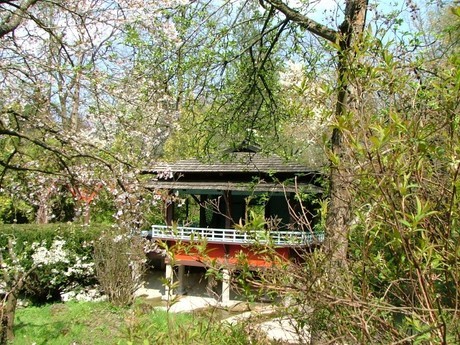The Botanical Garden
The Cluj-Napoca Botanical Garden, officially Alexandru Borza Cluj-Napoca University Botanic Garden (Romanian: Grădina Botanică Alexandru Borza a Universităţii Cluj-Napoca), is a botanical garden in Cluj-Napoca, Romania. It was founded in 1920 by Alexandru Borza.
The garden is over 14 hectares in area, with over 10,000 plants from throughout the world. It is divided into ornamental, phytogeographic (geobotanical), systematic (taxonomical), economic, and medicinal sections. Romanian flora and vegetation are represented by plants from the Transylvanian plains, the Carpathian Mountains, Banat, etc.
Among the Botanical Garden's interesting attractions are the Japanese Garden (a garden in Japanese style, with a brook and a Japanese-style house), the Roman Garden with archeological remains from the Roman colony of Napoca, among them a statue of Ceres, goddess of cereals and bread, alongside cultivated plants that dominate contemporary Romanian agriculture.
The Botanical Garden of the Babes-Bolyai University was founded in 1920 by Professor Alexandru Borza. Located in the southern part of the town, not far from the center, the Botanical Garden covers an area of 14 hectares, representing an oasis of cool in the hot days of summer, research and education institution and a wonderful place for recreation. There are illustrated the plant associations of the main regions of Romania and from different geographical areas of the world.
The garden contains more than 10 000 plant species from all over the world which are structured in several sectors: ornamental, phyto-geographic systematically, economic and medicinal. Among the garden attractions there are included the Japanese Garden (a Japanese style garden with a brook and a Japanese-style house) and Roman Garden with archeological remains of the old Roman colony Napoca. The greenhouses houses exotic plants such as banana trees, coconut tree or different species of palm trees.
The Botanical Garden is affiliated to the “Babes-Bolyai” University of Cluj-Napoca; it was founded in 1920 by the university professor Alexandru Borza. The garden is organized based on rigorous scientific principles as far as the plant classification and phytogeography are concerned; this is harmoniously combined with the artistic refinement which turns it into an extremely charming and picturesque site.
The garden spreads over 14 hectares of hilly land, which seems to favor successfully the growth of extremely diverse types of plants, coming from every corner of the world. The plant collections account for around 10,000 distinctive groups. The area is divided into several sections based on the special type of the plants: ornamental, phytogeographic, systematic, economic and medicinal. The Romanian flora is well represented by the vegetation characteristic to the Transylvanian Plain, to the Carpathian Mountains, to the regions of Banat and Oltenia, to the seaside dunes, etc.
One of the main attractions here is the Roman Garden, dominated by the statue of the goddess Ceres and by several archeological artifacts dating from the Roman age of the Napoca municipium. This section is meant to depict an ancient Roman garden with the vegetables and flowers that were then cultivated and which are still to be found in our peasant gardens nowadays.
The location of the Botanical Garden also hosts the Botanical Institute, where the specialists from the College of Biology and geology perform their research. The Botanical Museum exhibits 6,900 vividly colored items and the University Herbarium comprises 635,000 herbarium sheets with plants from all over the world.
The Botanical Garden publishes the following magazines: “Contributions to Botany”, the publication which promotes the scientific reports made by the specialists in botany from Cluj, “The Seed Catalogue”, based on which the institute settles seed exchanges with almost 500 other similar institutions from 82 countries and “Flora Romaniae Exsicca”, which facilitates the exchanges of herbariums between several botanical institutes throughout the world.
The Botanical Garden supports the higher education in this field. It stands for a laboratory where specialists have the best opportunity to study the life of plants, and to discover means of protecting the rare plants and the natural ecosystems, of preserving the vegetal germ plasma. It also accomplishes the noble mission of educating the people in the spirit of respect and love for nature.
Some of the main attractions: The ornamental section – here, tens of different species comprising hundreds of varieties of ligneous and herbaceous plants enchant the visitors’ eyes since the early snow melting until the first winter frosts; The Japanese Garden – the Asian flora is cultivated here in the intermediary traditional style gyo-no-niwa; the beauty of this site is enhanced by specific features of landscape architecture; The greenhouse complex – it consists of six greenhouses which host equatorial, tropical and subtropical plants, such as the famous Amazonian nenuphar, the impressive palm trees, the Australian and Mediterranean plants, orchids and tropical ferns; The systematic section – this is of the most important sections in the Botanical garden; it stands for a real living botany textbook, in which species are grouped into families, the latter into orders and classes, which are all arranged in phylogenetic order.
The variegated relief is favorable to arrangements of plants from different parts of the world, as the Himalayas, the Caucasus and the Balkans, as well as from Romania, grouped in regions. Many plants were integrated in a beautiful Japanese Garden. Opposite the alley, there is a Roman Garden dominated by the statue of goddess Ceres, with plants and elements of Roman archaeology discovered in the town aiming to restore its original look.
There is a tradition for the newly wedded couples to make photos in the Garden, as well as for groups on different occasions, which is not approved by the leadership of the institution.
In a town where the green areas tend to become more and more scarce, the Garden is an oasis of quietness, relaxation and an interesting place to explore.




